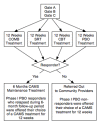Child/Adolescent Anxiety Multimodal Study (CAMS): rationale, design, and methods
- PMID: 20051130
- PMCID: PMC2818613
- DOI: 10.1186/1753-2000-4-1
Child/Adolescent Anxiety Multimodal Study (CAMS): rationale, design, and methods
Abstract
Objective: To present the design, methods, and rationale of the Child/Adolescent Anxiety Multimodal Study (CAMS), a recently completed federally-funded, multi-site, randomized placebo-controlled trial that examined the relative efficacy of cognitive-behavior therapy (CBT), sertraline (SRT), and their combination (COMB) against pill placebo (PBO) for the treatment of separation anxiety disorder (SAD), generalized anxiety disorder (GAD) and social phobia (SoP) in children and adolescents.
Methods: Following a brief review of the acute outcomes of the CAMS trial, as well as the psychosocial and pharmacologic treatment literature for pediatric anxiety disorders, the design and methods of the CAMS trial are described.
Results: CAMS was a six-year, six-site, randomized controlled trial. Four hundred eighty-eight (N = 488) children and adolescents (ages 7-17 years) with DSM-IV-TR diagnoses of SAD, GAD, or SoP were randomly assigned to one of four treatment conditions: CBT, SRT, COMB, or PBO. Assessments of anxiety symptoms, safety, and functional outcomes, as well as putative mediators and moderators of treatment response were completed in a multi-measure, multi-informant fashion. Manual-based therapies, trained clinicians and independent evaluators were used to ensure treatment and assessment fidelity. A multi-layered administrative structure with representation from all sites facilitated cross-site coordination of the entire trial, study protocols and quality assurance.
Conclusions: CAMS offers a model for clinical trials methods applicable to psychosocial and psychopharmacological comparative treatment trials by using state-of-the-art methods and rigorous cross-site quality controls. CAMS also provided a large-scale examination of the relative and combined efficacy and safety of the best evidenced-based psychosocial (CBT) and pharmacologic (SSRI) treatments to date for the most commonly occurring pediatric anxiety disorders. Primary and secondary results of CAMS will hold important implications for informing practice-relevant decisions regarding the initial treatment of youth with anxiety disorders.
Trial registration: ClinicalTrials.gov NCT00052078.
Figures
Comment in
-
The importance of the discourse on the method.Child Adolesc Psychiatry Ment Health. 2010 Jan 7;4:2. doi: 10.1186/1753-2000-4-2. Child Adolesc Psychiatry Ment Health. 2010. PMID: 20150989 Free PMC article. No abstract available.
References
-
- Ezpeleta L, Keeler G, Erkanli A, Costello EJ, Angold A. Epidemiology of psychiatric disability in childhood and adolescence. Journal of Child Psychology & Psychiatry & Allied Disciplines. 2001;42:901–914. - PubMed
-
- Albano AM, Chorpita BF, Barlow DH. Child psychopathology. 2. New York, NY: Guilford Press; 2003. Childhood anxiety disorders; pp. 279–329.



